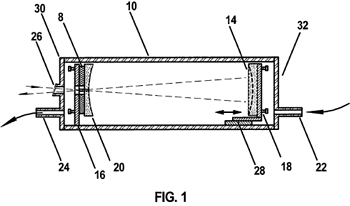Near Re-Entrant Dense Pattern Optical Multipass Cell
U. S. Patent No. 7,307,716, issued December 11, 2007
The sensitivity that can be achieved by absorption spectroscopy is determined
by Beer's law: the absorbance to be measured depends on the distance the light
travels through the sample. To achieve a long sample path in a small volume,
optical multipass cells are used. A particularly simple and robust cell design
was developed by Herriott (Appl. Opt. 3 523-526, 1966) and is still
widely used.  In
the Herriott cell, two curved mirrors face each other. The laser beam is injected
through a hole in one mirror, traces a pattern of spots along the perimeter
of each mirror, and re-emerges through the hole. The optical path length that
can be achieved is ultimately limited by the ratio of the beam spot size to
the perimeter of the mirror. Longer path lengths can be achieved by using
astigmatic mirrors, which allow the spot patterns to cover the surface of
mirror before emerging. However, such mirrors are quite expensive.
In
the Herriott cell, two curved mirrors face each other. The laser beam is injected
through a hole in one mirror, traces a pattern of spots along the perimeter
of each mirror, and re-emerges through the hole. The optical path length that
can be achieved is ultimately limited by the ratio of the beam spot size to
the perimeter of the mirror. Longer path lengths can be achieved by using
astigmatic mirrors, which allow the spot patterns to cover the surface of
mirror before emerging. However, such mirrors are quite expensive.
This invention describes a multipass cell based on a spherical mirror and a cylindrical mirror. It achieves the advantages of an astigmatic Herriott cell at a fraction of the cost. The beam can exit through the entrance hole (which can be on the optical axis) or another hole can be provided for extracting the beam. Up to 166 passes can be obtained, so path lengths can approach 100 m.
Contact Information
e-mail info@swsciences.com

